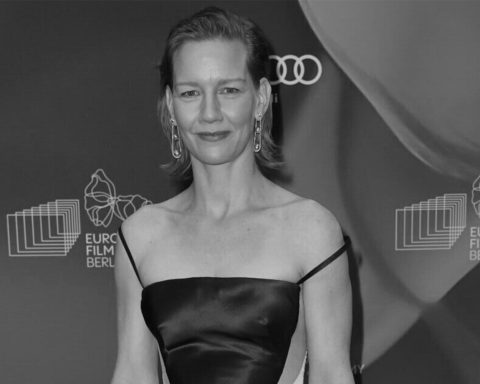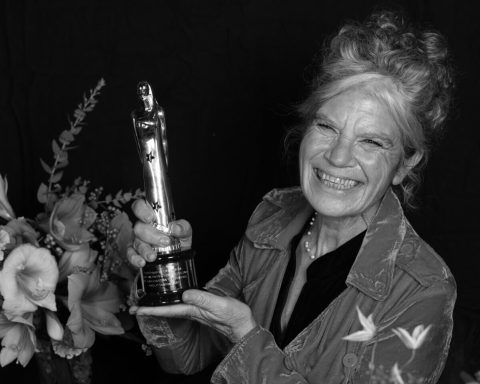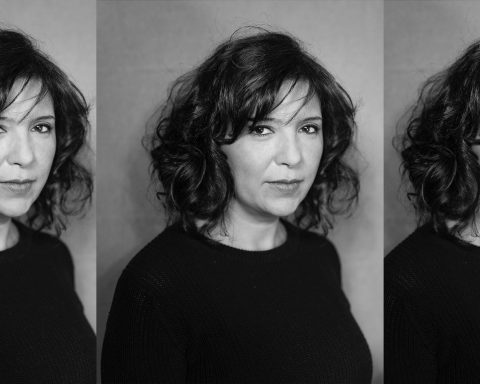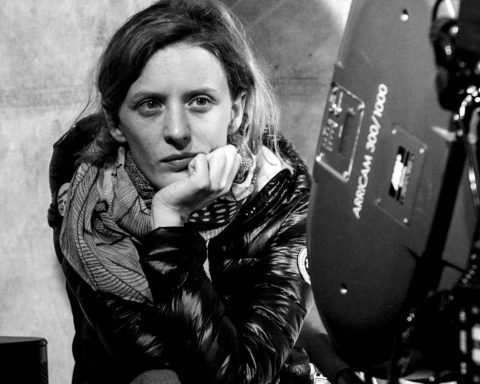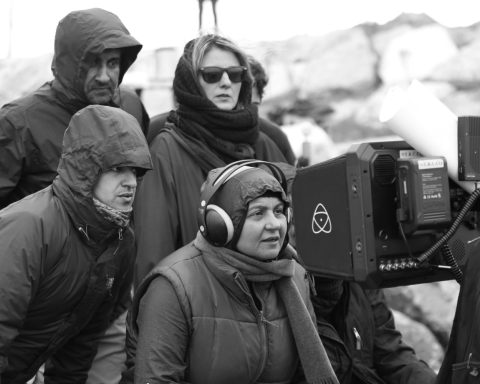Minna Dufton is an award-winning journalist, documentarist and TV industry professional with a cause. She has learned her craft by working in big broadcasting corporations such as ITN, BBC and Finnish Broadcasting Company Yle for over twenty years. Her longest post as Producer-Director lasted nine years at Yle and included making a number of successful TV series and documentaries such as “Docstop: Saara Aalto,” a biographical documentary about Finnish singer and songwriter Saara Aalto. Minna’s mission is to bring complex and inspiring stories to the screen in a healing manner. She believes that showing vulnerability is the key to showing courage. Minna comes from North Karelia, a rural part of Finland, and is passionate about making high quality TV documentaries and films for TV audiences far away from cinemas and film festivals.
Tara Karajica talks to Minna Dufton about her first feature film, “BIG vs SMALL,” that follows champion Portuguese big wave surfer Joana Andrade who is conquering her fear of drowning and finding herself locked in combat with long-buried demons under a frozen Finnish lake. It is a modern-day fairytale about power and strength on top of the water and facing demons under it. It’s about trust, letting go, and what happens when two elite champion athletes share their extraordinary talents with each other. “BIG vs SMALL” had its world premiere at this year’s Helsinki International Film Festival – Love and Anarchy and has screened at the Hot Spring Documentary Film Festival.
How did BIG vs SMALL come about?
Minna Dufton: Two years ago, I left Finnish Broadcasting Company Yle after nine years to do my own thing, to do programs that looked like me and to also develop myself. I found that maybe I wasn’t developing as much as I wanted to and so, I set out on my own and decided I would only make films that I felt really challenged me and would help me grow and help the world in some way. I want to make films that make an impact and I want to talk to people and make them feel things through my films.
So, when I came across a BBC news article about women who surf the biggest waves in America and who were fighting for equality, I was instantly attracted to the genre. Female topics, female empowerment and women doing awesome things have inspired me before and I knew I wanted to make another film about a woman who did something pretty extraordinary, so the idea started to develop in my head. I began to watch big wave surfing and I actually went to learn to surf because I was so inspired. I love the ocean and I’ve always loved watching waves, so I was combining things that were interesting to me and through that, I found myself in Portugal just after I had left Yle. I booked myself on a week’s course to learn how to surf and do yoga; it was partly a break after a long time in TV and a research trip. On that trip, I was lucky enough to meet some members of the big wave surfing community in Portugal. I had watched a lot of videos from Nazaré, where the biggest waves in the world are, and I knew the story was already taking me.
So, I threw myself in it and during that week, I learnt how to surf – scary as hell! I also first heard about Joana Andrade, the subject of BIG vs SMALL. I heard she was the only Portuguese woman to surf in Nazaré and only one of two European women who surf there and that she is tiny – only 156cm tall! I’m 158cm tall and I really felt for her. And now, I know that when she first heard from me, she was really surprised that a filmmaker from Finland was interested in meeting her.
How did the story evolve then?
M.D.: I spent two or three days with Joana when we first met in June 2018. She drove me around Ericeira and took me to meet her friends and showed me her home and her office, which is this garage where all her surf boards are – a place with the most cinematic views of the Atlantic Ocean. Then she told me her story. That was when I learnt the real reason why she surfed these monstrous waves. I have worked with a lot of great people before, people who have done or created extraordinary things and I don’t remember anyone who hasn’t gone through some kind of upheaval or trauma in their lives. People who go on to do great things often have to face great challenges. With Joana, I understood that the ocean, the surfing and the big waves were what helped her deal with her past.
Shooting these waves, under water and under the ice must have been complicated, but it’ so wonderful and so powerful… Can you talk about the shooting process?
M.D.: I’ve always been one to challenge myself and have sought projects where I am with people who inspire me and who might help me develop. This project presented me with plenty of that. Surf filming was something I had never done before, but I knew I could do this with the help of the right people.
I met Tim Bonython, the surf cinematographer in the film, back in January 2019 when my team and I were in Portugal to see what the conditions were like in Nazaré. Our cameras were nearly flying off the cliff with the wind, and then there was the incredible noise and spray from the ocean! Tim gave me his card and said to me: “Look, if you need any help filming in the water, let me know.” Tim’s one of the very few people who actually go and film in the giant waves. So, after that trip, I knew I had to connect with Tim. We scheduled the filming of the big wave surfing to a period last Autumn in Nazaré. My team and I based ourselves in Portugal for almost a month and waited for the conditions to be right. Overall, we filmed for a period of two years.
In the ocean, Tim Bonython films with a Red Epic Weapon and that, with water housing, weighs about 12 kg. Having all that on your shoulder, you can’t hold onto anything and you have these gigantic masses of water coming at you at short intervals. Making films couldn’t really get much more dangerous than that! We had a walkie talkie connection to the team in the ocean and I directed from the cliff at the lighthouse with Sakke Kantosalo, my D.o.P., filming the land angle. We also used drones and Go Pros to film Joana on the waves, to catch as many angles of the action as we could.
The filming under the ice presented us with some different challenges. We spent two days in Heinola in December 2018 with Joana and Johanna Nordblad and the first day was to get Joana used to the cold water. The ice in Lake Sonnanen was only 2cm thick that weekend – that’s barely strong enough to keep you standing on it. I worked closely with Johanna on how we were going to do our filming safely. What you see in the film is exactly what happened. The under the ice situation was really nerve-wrecking and even now, when I watch that part of the film, I find myself holding my breath.
I did the same when I was watching that part!
M.D.: But to see what the cold-water training did for Joana was something I’ll never forget.
What have you learnt while making this documentary, not only about surfing, but on all levels because it was something quite extraordinary?
M.D.: I think fear is one of the most interesting topics in the world and it offers an endless amount of opportunities for journalists, documentarists and the film industry. For me, personally, BIG vs SMALL was a test of my own mental sharpness, not least for the fact that I’ve had to self-finance a very challenging project. At the same time, knowing that I had to take a risk, was the test I needed in my career. And now, as we’re getting some very exciting invitations to film festivals and our journey to audiences is well on its way, I’m really happy that I stood the test. This film is my equivalent to going freediving under the ice or surfing a big wave.
You bringing Johanna in, was it to help Joana, or was it to give the film another perspective?
M.D.: When I first set out to make this film, I was going to make a documentary about a woman who was doing extraordinary things regardless of her size. But then, I learned that Joana had nearly drowned four times in her life and that she had this fear of drowning and that really stopped me to think. I had heard through talking to big wave surfers that the best way to learn to survive in a wipeout situation where you’re inside a big wave, is to go free-diving under the ice. I knew Johanna was the person who could help us, so I contacted her and it was Johanna who came up with the plan to take Joana under the ice.
Can you talk about the title?
M.D.: I’ve always been attracted to the relationship between big and small. I’m small in size and I think it’s interesting how we, regardless of our size, can face big challenges and the title reflects that.
I know how it is to be small! I’m 157cm tall, so I know exactly what you’re talking about! Sometimes, I can’t even reach my kitchen cabinets!
M.D.: In History, Napoleon, for example, was small. Small people have gone on to do some big things and I wonder whether it is partly because of their physical size that they have to put in this extra mental effort. Because with a small person, everything is small and when you’re small, you do see the world from a slightly different angle.
I know exactly what you mean! So, I saw on Instagram that you had a coat and a mask made with rejection letters you received when you applied for funding and you wore them at the film’s premiere at the Helsinki International Film Festival – Love and Anarchy. Can you talk about that?
M.D.: I received a lot of rejections for funding during the making of this film, so it’s been quite a ride.
I made a speech about this at our test screening in February this year and in it, I joked that I could make a dress out of all the rejection letters I got – I had so many of them! As it happened, Riikka Manni, the owner of the fashion label Frida Fiasko, was in the audience. After my speech, Riikka came up to me and said: “Look, I’ll make you this dress. I already have a picture in my mind of what it’s going to look like.” I emailed some of my rejection letters to her and she made this fabric and together we developed it over the pandemic. The dress turned into a jacket, which is called “Rejected” and then, I came up with the idea of a mask.
It was an important statement for women in the film industry because it’s a fact that we struggle to get the big money. It really is something we have to focus more on. We need to find more innovative routes to help us finance our films and we need to talk about this more. Being rejected for funding is one of those things that people are afraid to speak out about in the fear that they would not get funding next time. With the demand for great storytelling on the up, more avenues for funding are needed.
This leads me to my next question, what do you think of the situation of women in the film industry? How is it Finland?
M.D.: Gender equality in film and TV has been in the headlines a lot here. I’d like to see more focus on making sure public funding is shared equally between big and small production companies – and that there are also funds available for first time filmmakers. Right now filmmakers who are starting out are left to take huge financial risks with their first productions and filmmaking is risky enough as it is.
What kind of impact do you think the film will have on many levels?
M.D.: I hope it will encourage more women and girls to surf, and to boldly go out there, but, really, it’s a film for anyone who wants to be inspired. In terms of the film industry, I think this film has what it takes to show that small production companies and lone filmmakers can do what bigger players can. On a more personal note, I’m forty-three years old with a long career in TV behind me and I’m now out there with my first feature film. Age or size really don’t matter!
Exactly! Do you have a favorite female filmmaker and a favorite film by a female filmmaker?
M.D.: My favorite female filmmaker is Sofia Coppola and my favorite film by a female filmmaker is Lost in Translation.
Times are uncertain now, but are you working on something for when times are better?
M.D.: I’m in the early development stages with an eight-part documentary series on fairytales and the meaning of fairytales in the modern world. I’m the series producer and one of the writers. This project also has a female director.
Photo credit: Elina Manninen.
This interview was conducted during the 2020 (hybrid) Hot Springs Documentary Film Festival.



